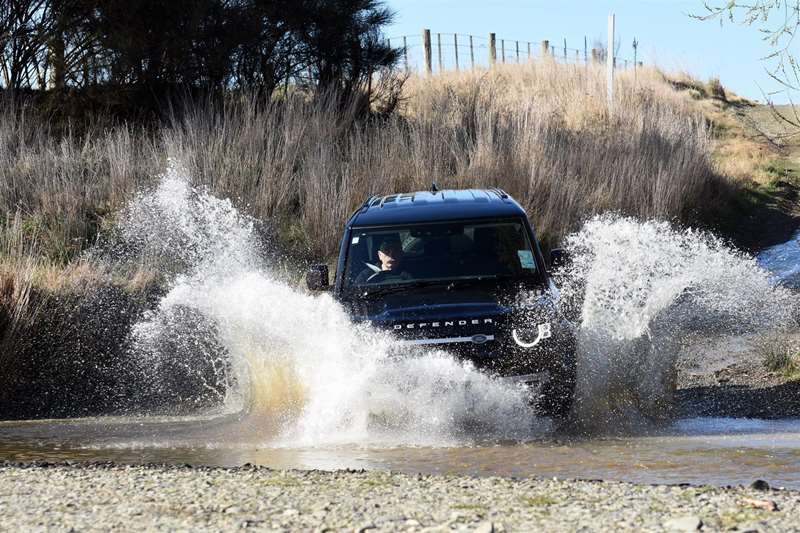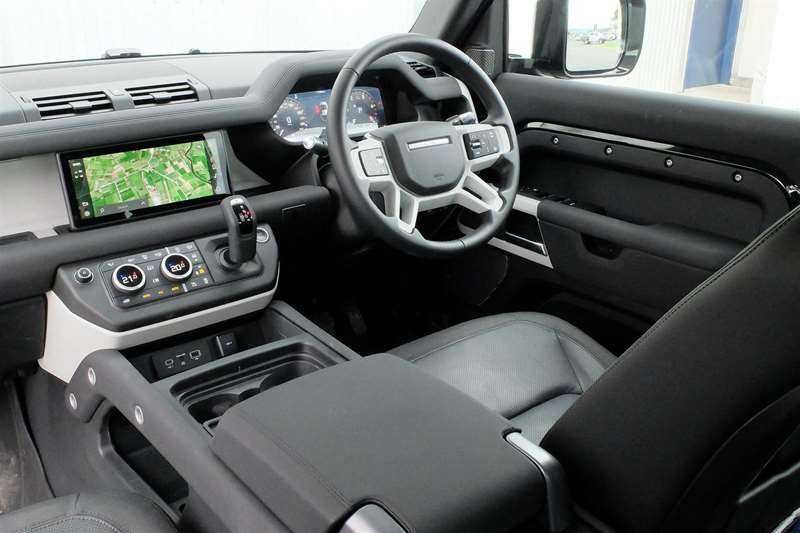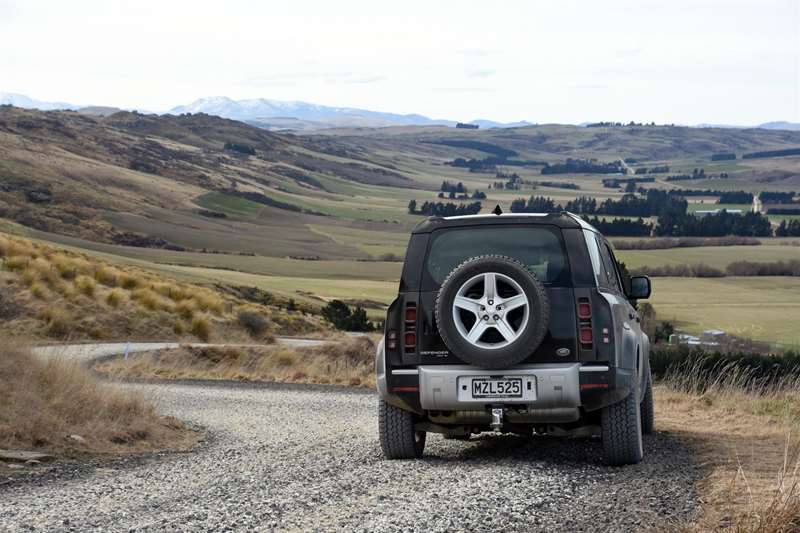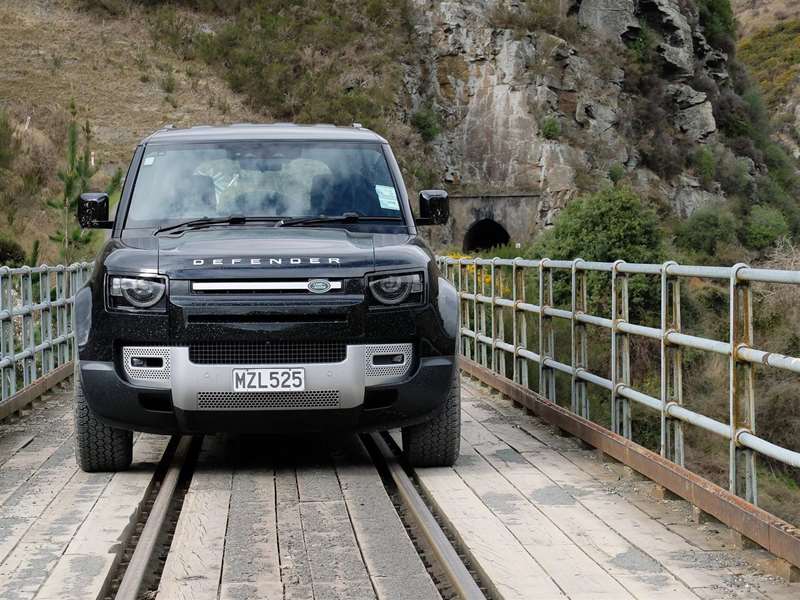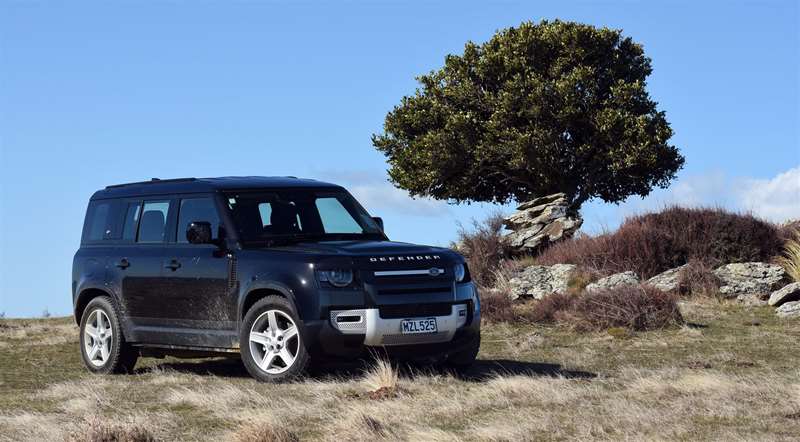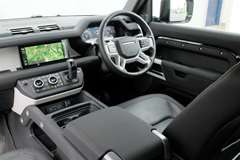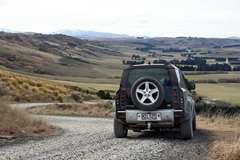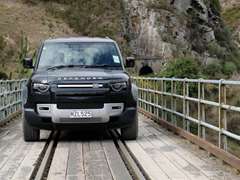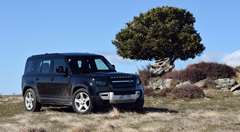After a four-year absence, the Defender has returned to the Land Rover Range. David Thomson tests this all-new take on the original theme on local roads and trails.
What’s new?
When Land Rover retired the Defender in 2016, it terminated a look and engineering lineage stretching back to 1948.
The new Defender does not seek to re-start that lineage. Rather, it reinterprets elements central to the original Land Rover ethos in a thoroughly modern way, focusing on the distinctive looks and rugged, goanywhere capability.
So, while the classic look is referenced in the new machine’s styling, its body is integrated into the underlying platform, rather than attached to a separated ladder frame chassis. And, while the choice of aluminium panelling for the Defender plays true to the original Land Rover, the reasoning for its use has changed — back in cash-strapped post-World War 2 Britain, warsurplus aluminium panelling was cheap and plentiful — this time round, it is favoured for its weightsaving qualities. Within the cabin, nods to the past mix with much that is new, including a contemporary in-car infotainment system.
The five-door 110 model is the only Defender available from launch, and Covid-19 disruption means even it is in short supply. Amix-and-match choice of four powerplants (including amild hybrid) and five equipment specifications (standard, S, SE, First Edition and X) are offered. Additional customisation is provided via four accessory packs and a lengthy array of options.
Orders are already being taken for the shorter Defender 90, too, due here in early 2021. A longer version, the 130, is also in the pipeline. As this is emphatically a Defender for the 21st century, we can expect afull plug-in hybrid version in due course.
Looking at the 110 line-up, prices start at $89,990 for the utterly unadorned Defender 110 with a 147kW 2.0 litre engine, and run through to $164,900 for the flagship 294kW P400 Defender X mild hybrid. Power delivery for all versions is to all four wheels via an eight-speed automatic transmission.
The vehicle supplied to Drivesouth for appraisal was the Defender 110 D240 SE. The 240 denotes the 177kW version of the 2.0 litre turbodiesel engine.
What comes as standard?
Evidence that there really is no such thing as a standard Defender comes in the 32-page specification and price guide. The guide advises a six-step process, starting with the basic model, and then working through choices of the engine, accessory pack, exterior, interior and general options.
As a 110 SE with few extras, the test car was fitted with air-suspension and shod with 255/60 all-terrain tyres and 20-inch alloy wheels. Its exterior also featured premium LED headlights, LED tail lights and front fog lamps.The seat trims were mixed grained leather and woven textile upholstery, and the front seats were heated and power adjusting. Seat heaters were also provided for the middle and rear seats. Centred on a 10-inch touchscreen display, the infotainment package included a 10-speaker sound system, satellite navigation and smartphone mirroring.
The active safety package embraced adaptive radar cruise control, lane keeping assist, blind spot assist, rear traffic and rear collision monitoring. Further driver aids included wade-sensing, a multimode off-road system and a 360-degree parking aid. Its sophisticated camera system included surround-view 3-D, with special modes for off-road operation.
What’s it like to look at?
At more than 5mlong, around 2m wide and almost 2m tall, the Defender 110 is a substantial machine.
Its core styling draws on elements central to the original Land Rover design. These include flat, slabby flanks, a low window line, a bluff nose,an equally flat rear with its side-hinged tailgate and rear-mounted spare wheel, and a windscreen that is as upright as is permissible to meet current international safety regulations.
Several Land Rover traditionalists encountered on test enthused about the new look.
What’s it like inside?
The cabin is a huge advance on that of its venerable predecessor. It’s far more spacious, and the quality of materials is very good. The overall effect of functional industrial chic — rather than plush luxury — suits the character of the new Defender to a tee.
Configured as a seven-seater, the test car mustered a generous 743 litre luggage space behind the rear seats, expanding to 1826 litres with the rear seats folded flat. The boot space included three-pin and 12-volt sockets, along with robust tie-down points. The only niggle cargo-wise is that access to the luggagearea is compromised by the side-hinged tailgate, but the ride height is adjustable via a button in the boot for convenient loading.
Stowed as theboot floor when not required, the third-rowof seats comes with its own bottle holders and air ventilation control. Spacewise this rowis best suited to kids but, if required, can accommodate average-sized adults.
The excellent middle seats provide ample leg and head room. There is afold-down centre armrest, dual-zone climate control and no fewer than fourchargeable USB points, as well as two 12-volt sockets.
Separated by a wide centre console, the front seats are broad, supportive and very comfortable. Front seat head and shoulder room is outstanding. Helped by the relatively low waistline, the command-style driving position provides brilliant visibility. The view to the rear is hindered by the tailgate and spare wheel, a situation mitigated by a rear-view camera integrated into the rearview mirror.
While the lidded centre console bin is not especially large, the front of the cabin boasts a generous array of storage trays, shelves and compartments, along with USB and USB-C plugs. There is a substantial grab handle for the front seat passenger, and the handle — like the dashboard of which it is a part — has a soft-touch finish.
The Defender is the first Land Rover model to feature the company’s new-generation infotainment system. It is clear, user-friendly and possessed of functions to make off-road driving easier. Other highlights ofthe system include seamless phone integration, and a‘‘photo’’ view option for the navigation system using high-quality satellite imaging.
Theseparationof climate control and drive function knobs and buttons below the displayscreen could be better, but learning to operate theseseamlessly should come with time behind the wheel.
What’s it like to drive?
Dignified, smooth and assured are three words that sum up the new Defender’s open road character and, in these respects, it is a million miles removed from the original.
Being tall, it’s not a vehicle to hurry through tarmac twists and turns, but the test car steered with reasonable precision. The ample low-down torque of the D240 engine combined with the slick shifts of the eight-speed gearbox delivered an easy-going mechanical character. Impressive refinement was another key on-road characteristic, evidenced most noticeably bya supple ride, excellent body control and low levels of wind and road noise.
Using gentle throttle pressure to surf the engine’s torque curve is part ofwhat makes this Defender a far better round-town vehicle than you might expect. Size is its main limitation in urban settings, but thanks to excellent visibility from the driver’s seat and the bevy of on-board cameras, negotiating city streets is fairly straightforward.
While most Defenders will spend most of their driving lives in urban environments, it’s also a genuine 4WD and with that in mind I headed for unsealed roads and unmetalled tracks and trails.
Land Rover’s proven Terrain Response and Hill Descent technology — operating in conjunction with height-adjustable air suspension, low-range transmission, locking centre and active rear locking diffs — is the key tool in the Defender’s off-road tool kit. The test car’s set of all-terrain tyres rather than suburban-friendly rubber was helpful, too.
Specific drive modes for different surfaces are selectable on the fly via a button on the centre console and a tap on the centre touchscreen. Mode tweaks adjust the steering, transmission shift protocols, suspension (including ride height), throttle control and power delivery.
Ride height can also be adjusted separately, from 218mm to 291mm. The latter setting maximises obstacle clearance with a 38-degree approach, 28-degree ramp and 40-degree departure angle, as well as enabling the Defender 110 to wade to a depth of 900mm. (It’s rated to climb or descend 45-degree slopes, though before attempting that on any unsealed surface, it’s surely best to stop, pop the gearbox into neutral, and push the button to select low ratio.)
Driving mainly on gravel, but negotiating a stretch of sand, a couple of decent water crossings, some rutted trails, patches of rocky terrain and a little mud, the test car remained sure-footed and supremely comfortable throughout. Sure, this wasn’t an exhaustive test of the new Defender’s off-roading capabilities, but in a full day exploring a selection of byways and trails — all within 50km of the centre of Dunedin
— it was possible to gain a feel for how much this machine can offer over roads and routes less-travelled.
Verdict
The task of replacing an icon is fraught with risk, and if Land Rover had done nothing more than produce a credible successor to the Defender of old, then its work with this new machine would have been well enough done.
But the new Defender is not merely credible, it is exceptional. As such, it is fully worthy of an accolade I rarely award: a maximum five-star road test rating.
